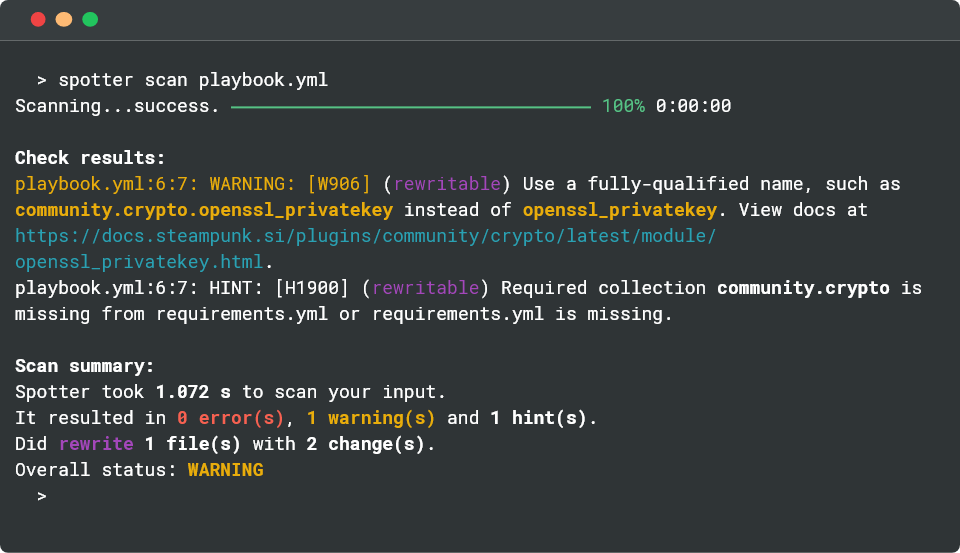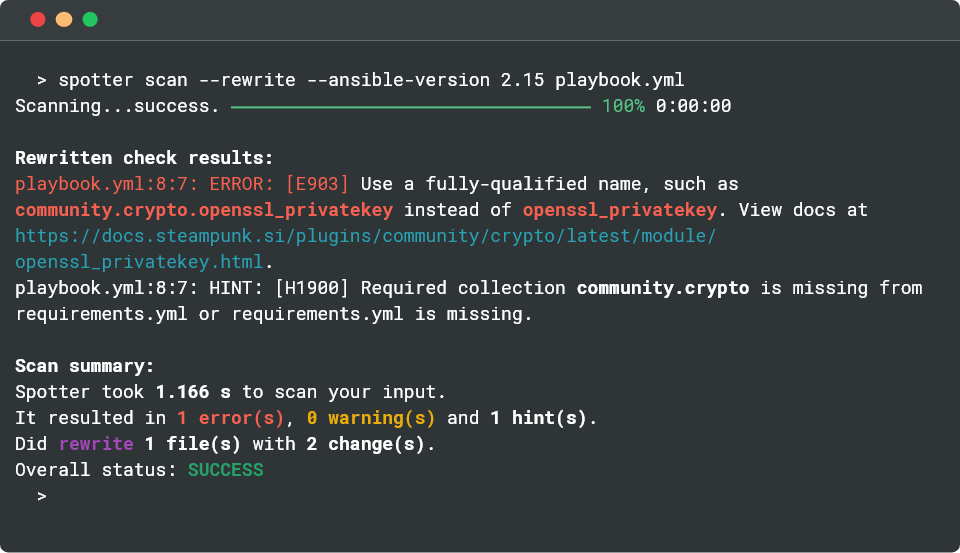

Steampunk Spotter
Trustable Automation
Ansible Playbook Platform that scans, analyzes, enhances, and provides insights for your playbooks.

82% reduction
in playbook errors
70% decrease
in code reviews
4x faster
code improvements
350% ROI
in one year








Reduce risks and speed up automation
Optimize your automation with improved playbooks that guarantee reliable execution. Create and maintain Ansible Playbooks with ease while ensuring they are always up-to-date and secure.
- identify hard-to-catch and time-consuming errors
- improve quality, reliability and security of playbooks
- reduce development and test time
- follow automation best practices
Calculate your time savings

Supports Red Hat Ansible Automation Platform

Checks all Ansible versions from 2.0 to 2.17

Windows compatible
Achieve secure playbook execution
Add an extra layer of security. Understand what will happen when you run the playbooks and follow security best practices to minimize security risks, downtime, and costs.


Optimize Red Hat Ansible Automation Workflows
Detect problems with playbooks before execution and fix unexpected errors during runtime to achieve robust and reliable automation workflows with minimized risks of failures and disruptions.
Easily upgrade to the latest Ansible version
Check if your playbooks are compatible with a specific Ansible version, identify issues you need to resolve, get advice on how to ease migrations, and upgrade playbooks in minutes instead of hours.
Gain insights for your scans
Analyze scan data, spot trends, monitor progress, and create custom reports with the intuitive reporting feature. Focus on delivering results and make data-driven decisions.
User reviews

Computer Space benefits greatly from Spotter. You could too.
82% reduction
in Ansible Playbook errors
100s of hours saved
in playbook optimization
70% productivity increase
in Automation Office
Spotter works where you work
Scan playbooks from command line
Simply install the steampunk-spotter CLI tool as a Python package.
Scan Git repositories from web
Use Spotter app to check the quality of public Git repositories.
Scan from CI/CD
Integrate Spotter with GitHub Actions and GitLab to scan content within CI/CD workflows.
Scan from your favorite code editor
Analyze and get recommendations for your playbooks directly in Visual Studio Code.
- Scan playbooks from CLI
- Scan Git repositories from web
- Scan in GitHub Actions
- Scan in GitLab
- Scan in Visual Studio Code
Who is it for?
Development
As a Playbook Developer, you come across different challenges. Documentation is lacking, there's no clear guidance on what's approved, and it's hard to
keep up with what's new and best practices.
Use the Spotter to:
- verify playbook templates or examples,
- check Ansible core and Collection versions compatibility,
- understand the implications of Ansible upgrades.
Quality Assurance
As a Quality Assurance Manager, you often wonder what the playbook will really do, especially when there's no documentation available.
Will there be a rollback? Will it break something in production?
Use the Spotter to:
- understand what will happen when you run the playbook,
- run QA automations without errors,
- understand best practices and what-if scenarios for your tests.
Operations
As an Operations Manager, you want to anticipate potential issues, but how to do that if you don't know what will happen in case of errors in the playbooks?
Or what will happen to them when a new Ansible version pops up?
Use the Spotter to:
- identify potential vulnerabilities,
- receive quality reports and recommendations for improvements,
- achieve reliable execution of automation.
Security
As IT's infrastructure continues to evolve and become more complex, it's nearly impossible for security specialists to keep
it secure at all times without the help of reliable tools.
Use the Spotter to:
- prevent misconfigurations and security breaches,
- ensure corporate standards of compliance,
- achieve secure execution of automation.
Development

As a Playbook Developer, you come across different challenges. Documentation is lacking, there's no clear guidance on what's approved, and it's hard to keep up with what's new and best practices.
Use Spotter to:
verify playbook templates or examples,
check Ansible core and Collection versions compatibility,
understand the implications of Ansible upgrades.
Quality Assurance

As a Quality Assurance Manager, you often wonder what the playbook will really do, especially when there's no documentation available. Will there be a rollback? Will it break something in production?
Use Spotter to:
understand what will happen when you run the playbook,
run QA automations without errors,
understand best practices and what-if scenarios for your tests.
Operations

As an Operations Manager, you want to anticipate potential issues, but how to do that if you don't know what will happen in case of errors in the playbooks? Or what will happen to them when a new Ansible version pops up?
Use Spotter to:
identify potential vulnerabilities,
receive quality reports and recommendations for improvements,
achieve reliable execution of automation.
Security

As IT's infrastructure continues to evolve and become more complex, it's nearly impossible for security specialists to keep it secure at all times without the help of reliable tools.
Use Spotter to:
prevent misconfigurations and security breaches,
ensure corporate standards of compliance,
achieve secure execution of automation.
Try On-prem for Free
Test drive Steampunk Spotter on-premise to experience its full power and enterprise features in your own infrastructure.
- Personalized Demo
- 1 Week of Testing
- Full Support
- Report of Cost & Time Savings







